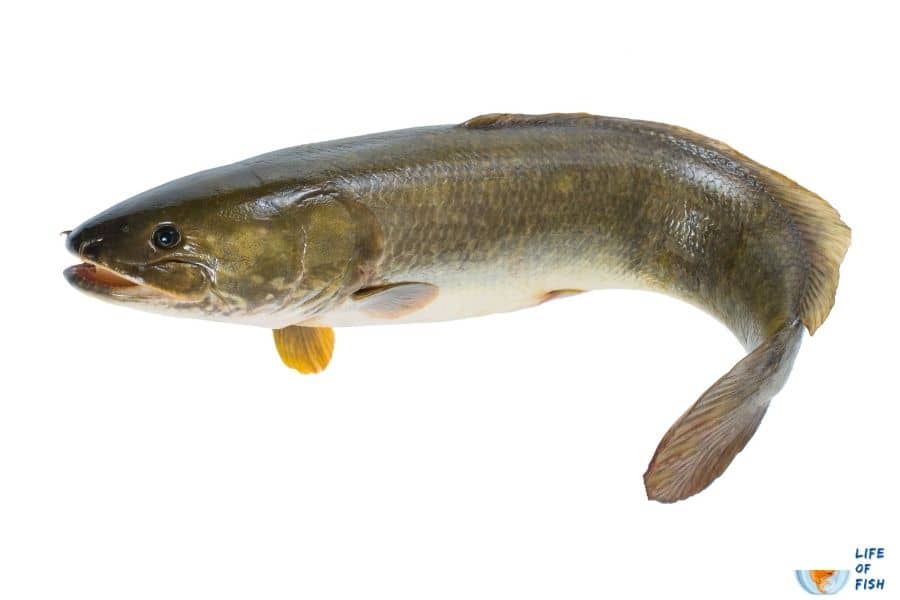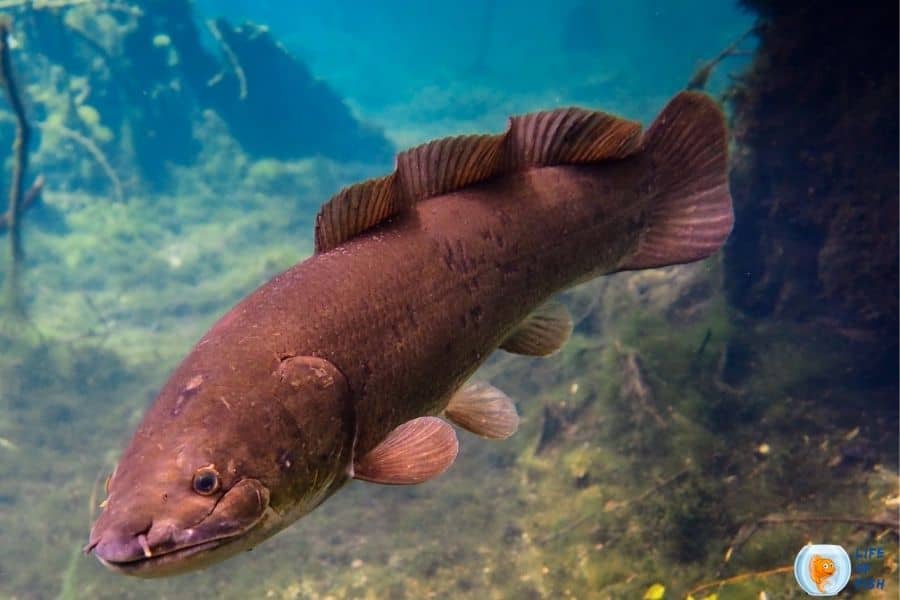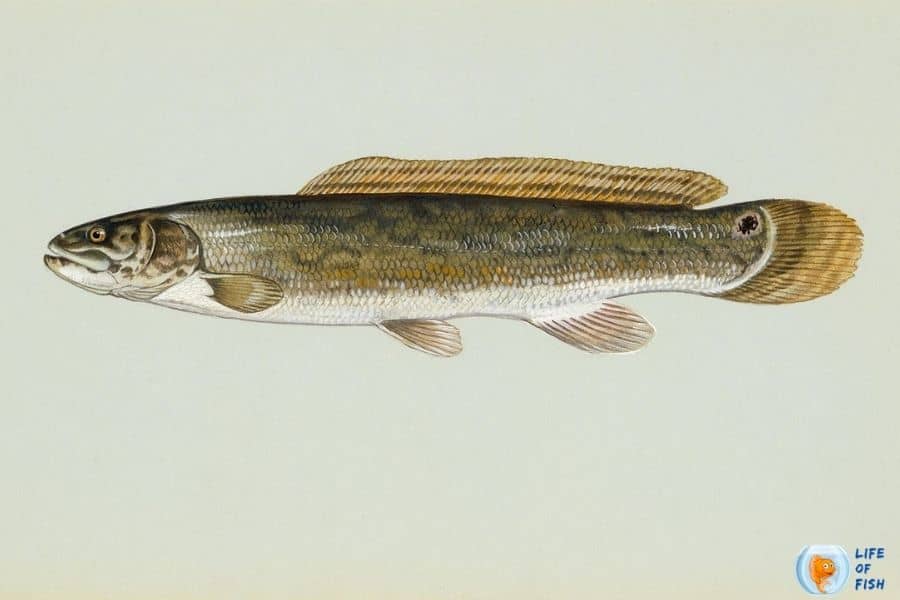Florida Mudfish are commonly known as Bowfin, dogfish, swamp bass, swamp trout and many other names.
But they are being called the worst names by anglers because Mudfish are considered trash fish among anglers.
Mudfish are the only surviving species of a group of fish named Halecomorphi that existed around 250 million years ago in the Early Triassic age.
Although anglers despise these fish, there are plenty of interesting facts and stories about them.
Let’s dig deeper into Mudfish in this article.

What is Florida Mudfish?
Jump To
- 1 What is Florida Mudfish?
- 2 Are Bowfin and Mudfish the same?
- 3 How Florida Mudfish looks like
- 4 Where Florida Mudfish live?
- 5 Florida Mudfish behavior
- 6 What do Florida Mudfish eat?
- 7 Florida Mudfish breeding
- 8 Importance of Florida Mudfish
- 9 Florida Mudfish Interesting Facts
- 10 What kind of fish is a Florida Mudfish?
- 11 Are Florida Mudfish rare?
- 12 Are Florida Mudfish poisonous?
- 13 Biggest Florida Mudfish ever caught
- 14 Conclusion
Florida Mudfish (Amia calva) is most commonly known as Bowfin. They are regarded as a relic fish species, a fish that survived from the early era.
They belong to the family Amiidae and order Amiiformes. In fact, They are the only living representative of this ancient fish family.
You can find these fish in various lakes, ponds, and rivers throughout the Eastern United States.
They are usually found in areas with loose substrates such as mud or sand that they camouflage themselves in to escape predators.
Young fishes are generally found in clear water with rocks and gravel substrate.
Florida Mudfish is considered among the primitive fish species. And it has many primitive characteristics such as pharyngeal teeth, dorsal fin with 46 to 50 soft rays, anal fin with9 to 10 soft rays, gill rakers short and bony.
Mudfish are close relatives to gars, another fish commonly known as primitive fishes. Both Amiidae and Lepisosteidae (another family of primitive fish) are the only living families in the order Amiiformes.
Are Bowfin and Mudfish the same?
Yes. We often find confusion about these two terms. Although they are the same, there is little difference between the usage of each term.
Bowfin is one of the common names of Florida Mudfish, a primitive fish found in Florida and other areas.
But now, Bowfin is used as a general term for all species belonging to the Amia genus. However, only Florida Mudfish (Amia calva) are living in the genus Amia.
Other common names of them are Bowfin, dogfish, mud bass, green fish, Grinnell, grindle, speckled cat, etc.
How Florida Mudfish looks like
Florida mudfish are not some fish that fascinate you by their appearance. They look more fierce than attractive. A big mouth with sharp teeth is enough to scare you off about these fishes.
Color
They are greenish-brown, olive, or dark brown, but flanks are yellowish-white. It has darkish brown cross bands and black spots, giving it a camouflage pattern.
The dorsal fin comprises horizontal bars, while the caudal fin is made up of irregular vertical bars.
The belly is white or yellow with many dark brown to greyish-black blotches. The abdomen is lighter than the rest of the body.
Shape
They have an elongated cylindrical body and a distinctive flat snout. They are laterally compressed and have a long stout look.
Florida mudfish have a long dorsal fin and a short anal fin. They also have rounded tail fin
The mouth has two sets of canine-like teeth and a large surface membrane on the underside of the lower jaw.
Size
They typically grow to around 20 inches, but they can grow up to 43 inches in length.
And a weight of about 21 pounds in some specimens is not surprising at all.
Life span
They have a shorter lifespan than most other fish. It generally lives for about 10 to 12 years, and some sources say that it can live up to 30 years if kept in captivity.
Male and female fish
Female mudfishes are typically larger than male fishes. Both have a green or orange spot behind the upper gill cover.
The male fish often have a black eyespot encircled by a yellowish-orange border on the base of the tail. Females usually don’t have this spot. If present, it will be all black.

Where Florida Mudfish live?
They often live in backwater pools of small rivers, ponds, and swamps. They need abundant vegetation for survival.
Florida Mudfish are commonly found in the backwaters of the Mississippi River.
And they prefer to live in areas with log jams or reed marsh. They also live in ditches, pits, and pools of slow streams where there is clear water and plenty of aquatic vegetation.
These fish are often trapped in drained pools after rainy seasons, and they seem to survive without water for as long as 21 days.
The fish can be found throughout the Eastern United States and even in Southern Ontario, Canada.
The Florida mudfish can also be seen as far north as Lake St. Clair, Michigan, and southern Wisconsin.
The optimum water temperature for Florida mudfish is around 22°C (71°F), and they tolerate a range of water temperatures from 15°C to 25°C (59°F – 77°F).
Florida Mudfish behavior
Florida mudfish is a very aggressive fish species that won’t even hesitate to attack any living being on land.
Therefore, they are nicknamed as meanest fish by local people.
Despite its unsymmetrical mouth, Florida mudfish is a very effective predator, and it can attack almost everything, including humans, if they are hungry.
However, Florida mudfish prefer to prey on other fish, including frogs and small snakes.
But if they are hungry enough, Florida mudfish is capable of eating turtles, snakes, water birds, including ducklings and even small alligators.
These fish are solitary fish that spend most of their time searching for food. They are voracious predators that surprise attack most of their prey by ambush.
Unlike many other ambush predators, Florida mudfish are suction feeders that use suction to catch their prey.
When these fishes are in hunting mode, they can actually burrow themselves in the soft mud and remain motionless for hours to wait for prey.
During the daytime, these fish prefer to stay in deeper waters. At night, they move into shallower waters.
What do Florida Mudfish eat?
Florida mudfish is a predatory fish and feeds on fishes, mussels, salamanders, tiny turtles, and tadpoles.
In general, the Florida mudfish is a carnivore fish that eats whatever comes in front of its mouth.
They are opportunistic feeders that feed on any animal that fits in their mouth, including dead fish washed ashore. Their diet includes insects, reptiles, fishes, carrions, crustaceans, mollusks, and amphibians.
Florida Mudfish breeding
Florida mudfish breeding season begins in late April and ends in early June. They spawn only once yearly and sexually mature at the age of 3 to 5 years.
The female Mudfish produces an average of 55,000 spherical eggs per year.
These fish breed in shallow, vegetated areas, and the female lays eggs to the nest built by the male, often from plant roots.
This fish species is a substrate spawner, and the female lies on the nest built on the substrate while the male circles her.
They perform a courtship behavior before spawning. Then, the female release her eggs into the nest, and the male releases his milt (sperm) to fertilize the eggs.
More than one female Mudfish can lay eggs in a male’s nest, and females frequently lay eggs in multiple nests.
Once the eggs are fertilized, female fish leave the nest, and the male fish aggressively protect the eggs until the eggs hatch, and the fish fry reaches 3 to 4 inches in length.
During this time, the male fish aggressively attack anything that moves to protect their babies.
The male fish will also attack inanimate objects such as sticks and leap out of the water to attack invaders.
Once the juvenile fish reach four inches in length, they will start to show solitary behavior like adults and move away from their parents to live by themselves.
Importance of Florida Mudfish
Ecosystem balance
Florida mudfish are voracious predators and are near the top of the food chain. That means they are capable of controlling the population of their prey.
Furthermore, these fish feed on any living or dead animal they come across. Therefore, these fish keep the balance between predator and prey in Florida water bodies.
Sportfishing
Although Florida Mudfish are not popular as “game fish,” many anglers and fishers in Florida still enjoy fishing for this fish.
This fish has a great fighting spirit and can put up an exciting fight when caught on light fishing tackle.
However, these fish are considered “trash fish” because they cause the decline in populations of many game fish like bass and bluegill.
Since these fish predate on these fish, they are considered non-game or undesirable species.
Some people also believe Florida mudfish are invasive species to the ecosystem where they are present.
As a food
Florida mudfish are edible, but people do not prefer to eat this fish because of their poor taste.
The flesh of Florida Mudfish has a poor texture and tastes bland. People often avoid catching these fish for food as more delicious fish are caught in the same habitats (like crayfish).
If caught, they tend to kill these fish as Mudfish are known to eat many “food fish” like crayfish, bluegill, and bass.

Florida Mudfish Interesting Facts
- Florida mudfish are closely related to gars, another primitive fish that lives in North America
- They are bimodal breathers which means they can breathe air and in the water. They have a gas bladder that helps them to “breathe ” in both mediums.
- In English, Florida Mudfish are called frogfish, but they are not related to frogs. This name was given to these fish because of their ability to “walk” on land. They walk on land by undulating the body side-to-side over the sand and mud of the bottom.
- This mudfish live in one place all their life and hunt for food in the same area.
- Florida Mudfish are often mistaken for several fish species, including Nothern Snakeheads and Burbots.
- Florida mudfish can tolerate warm acidic waters as well as cold waters. They become inactive in waters below 10C and still survive.
- Florida Mudfish is the only extant species of the Genus Amia.
- Florida Mudfish are prone to liver cancer and Leukemia.
Related Questions
What kind of fish is a Florida Mudfish?
Properly known as Bowfin, Florida Mudfish is a bony fish from the Amiidae family. This is a primitive fish belonging to the order Amiiformes, which includes ray-finned fish.
Are Florida Mudfish rare?
Florida mudfish are not rare and abundant in their natural habitats. They are listed as Least Concern in the IUCN Red List because of their wide distribution and stable population.
Are Florida Mudfish poisonous?
Florida mudfish are not poisonous and are edible. However, they are not tasty as other fish and are not a popular catch due to their poor taste.
Biggest Florida Mudfish ever caught
The longest Mudfish caught was 34.3 in (870 mm) long, and the largest Mudfish caught weighed 21 lbs 8 oz (9.8 kg). The largest Florida mudfish caught from South Carolina in the United States.
Conclusion
Florida mudfish are primitive fish that still survive in their natural habitats, with no significant threats to their survival.
They are considered the meanest fish in the world because of their highly aggressive nature.
Florida mudfish are an essential part of the North American ecosystem. Although not considered desirable by anglers, these fish play an essential role in keeping the food chain intact.
Florida mudfish are edible but have a poor texture as well as a poor taste. They are not a popular catch and are often killed for eating other fish.
Read Next : Can Bowfin bite you? | 16 Astonishing Facts You Never Dreamed Of |
Read Next : Black Ram Cichlid Care | 11 Astonoshing Fish Care Tips |
Read Next : Snakehead Fish | 13 Interesting Facts About This Monster Fish |
